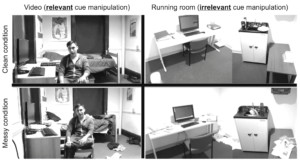
As a result of smartphones, tablets, and other devices being entrenched in our lives, our attention is in high demand as we switch between multiple devices, a behavior known as media multitasking. Indeed, we may find ourselves mindlessly scrolling through our Twitter feed on our phone and then suddenly checking our email on our tablet. Because this behavior is new for our species, the impact of media multitasking on how we perceive and interact with the world and those around us is not well known.
Previous work has shown that frequent media multitasking is linked to altered cognitive processing, whereby irrelevant stimuli exert a disproportionately strong “pull” and negatively impact performance on various cognitive tasks. This led us to wonder whether regular media multitaskers might also incorporate irrelevant stimuli when thinking about other people, specifically when making impressions and judgments about another person whom they never had met before.
 We hypothesized that in general, participants would use relevant information during impression formation, but that those who reported more frequent media multitasking would also, unwittingly, use irrelevant and extraneous stimuli in the environment that would affect their impressions of the other person.
We hypothesized that in general, participants would use relevant information during impression formation, but that those who reported more frequent media multitasking would also, unwittingly, use irrelevant and extraneous stimuli in the environment that would affect their impressions of the other person.
To test these hypotheses, we randomly assigned participants to watch one of two versions of a video in which a previously unknown person – allegedly a peer but actually a confederate – talked informally about their day while sitting in their (presumed) dorm room.
In one version of the video, the room was clean and organized, with various items neatly arranged and the floor clear of clutter. In another version of the video the room was generally messy and in disarray, with clothes and other personal effects strewn about the bed and floor. These neat/messy cues in the video served as potentially relevant information when forming an impression of the person (e.g., the person is tidy, or messy/disorganized).
Next, we randomly assigned participants to complete the experiment in a testing room that was actually neat or messy. We reasoned that the neat/messy cues in the testing room would be incidental and irrelevant, thus having no bearing on participants’ impressions of the person they saw in the video. In addition to experimentally manipulating both relevant and irrelevant cues, we measured participants’ tendencies to engage in media multitasking behaviors.

Replicating previous work by Samuel Gosling and others, we found that participants did incorporate relevant cues from the video when forming their impressions of the unknown person; those participants assigned to view the messy version of the video gave lower ratings of the person’s conscientiousness compared to participants who viewed the clean version of the video.
…media multitasking may in fact be associated with altered person perception in unexpected and unintended ways, with frequent media multitaskers unknowingly taking in otherwise irrelevant information from their environment when they perceive other people.
Next, consistent with our hypothesis, we observed a significant interaction between the testing room condition (featuring irrelevant cues) and media multitasking, such that frequent media multitaskers assigned to complete the experiment in the messy testing room gave lower conscientiousness ratings, relative to ratings given in the neat testing room. There was no such pattern observed for participants who reported average or infrequent levels of media multitasking.
From these results, we concluded that media multitasking may in fact be associated with altered person perception in unexpected and unintended ways, with frequent media multitaskers unknowingly taking in otherwise irrelevant information from their environment when they perceive other people. If this is true, then perhaps this process is also at play in other domains, such as encountering environmental cues that elicit eating behaviors or various emotions.
There are a few caveats that are worth mentioning that we hope will inform future research. First, the generalizability of these findings is only limited to the college-aged population. It is not clear whether these effects would also be observed in other age groups. Additionally, we did not manipulate participants’ media multitasking behaviors directly, so a strong causal link between media multitasking and person perception cannot be made. However, future work may be able to identify preceding factors that put people at higher or lower risk of becoming frequent media multitaskers in the first place.
Comments